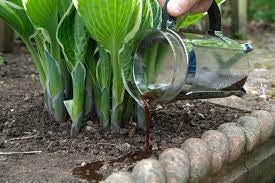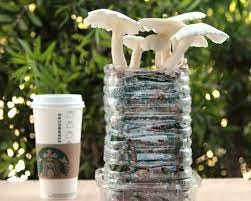A quiz question while you sip your morning cup of joe: What do that latte, radishes, blueberries, hydrangeas, and oh-so-many-more plants have in common with cosmetics, hair care products, cookies, and pizza?

Coffee grounds.
Conveyors of caffeine, they’re not dregs. They’re gold dust. Each coffee bean is a cornucopia of antioxidants, fatty acids, proteins, and diterpene esters (whose qualities we shall pass over since the explanation is gibberish to anyone but a scientist).
And they each benefit our health, our skin, and general well-being. But a cup of common coffee created by the ratio of 1 measure of ground coffee to 15-18 measures of water only delivers 1 percent of them. The rest remains in the grounds which are tossed out - perhaps to the benefit of your plants if you garden. But not to you.
Now that our attention is so closely focused on what is being sent unnecessarily to landfills, it’s probably no surprise that coffee grounds have come under scrutiny. You may have thought they were good only for those disappointing body scrubs you’ve read about in beauty columns. If you’ve been seduced by them, by the time you’ve been under the shower abrading your skin with the debris of your AeroPress or Bialetti, you notice the water is no longer draining away. Swirling around your toes is a sludge of grounds damming up the plug and you need a teaspoon to scrape them into the bin.
They deserve more respect. That debris has now been found of value in shampoos, conditioners, scalp masks, hair masks, scalp oils and serums. Also soaps, body washes, and cleansers. They are of use in face and body creams, foundations, concealers, moisturisers, sunscreens, mascara, and brow tints.
This, though, is a food newsletter, not a beauty consultancy. So, I’m impressed that along with all those other virtues, coffee grounds can also be applied in baked goods, cookies, bars and snacks, along with pizza and pasta. Spaghetti al cappuccino, anyone?
The history of coffee’s discovery and early use I’ve already written about, but not about how much is now consumed. Around 2 billion cups of coffee are estimated to be drunk globally, according to the British Coffee Association. On average, an Italian drinks 4 cups of coffee a day and there are 58,870,762 of them (yes, I know that includes babies but I’ve seen babies down babyccinos) which totals 235,483,048 million coffees in la bella Italia alone. In bean weight, the Finns drink 12kg/26lbs per person a year, the Norwegians 9.9kg/22lbs, the Icelanders 9kg/20lbs, and the Danes 8.7kg/19lbs. (Surprisingly, given Frank Sinatra’s Coffee Song, the Brazilians only drink 5.8kg/12.78lbs annually per person.) But given those numbers, 2 billion sounds to me like an underestimate. A web site called Hello Tea Cup would agree. It reckons the Vietnamese alone drink 17 billion cups, in a population of 97 million. (The site might have made a typo I myself am prone to - ‘b’ instead of ‘m’…)
It’s always puzzled me just how much coffee we drink when so much of it is so bad. My father dubbed undrinkable coffee GP. Crudery Alert: It stood for Gnat’s Piss. I never understood this disparagement involved a silent ‘G’; so it was years before I realised that it wasn’t Nathaniel’s urine he was referring to. (And I had no idea what that ‘g’ was for.) I’ve just come back from a trip around Spain where unless you order a cortado, an espresso with milk, the coffee is pretty low end. The French don’t know how to make good coffee, either. Roasted chicory’s associations with French coffee began during the Napoleonic Wars when coffee was in short supply, either added to the beans or substituting for them entirely. It’s still a popular ingredient in their coffee today but makes a disappointing cup for those not accustomed to it.
Not as abysmal a cup, though, as coffee in America, which even with the rise of Seattle-based producers is too often GP. In their chains, it’s an abomination, more a hot flavoured water.
The US and UK dependence on a take-out coffee, as if it were impossible to make any journey from A to B without clutching a cup to nuzzle while striding down streets, is curious. It seems to be a generational thing. People with ‘Senior Travel Passes’ are less likely to be clinging to cups like a comfort blanket. But perhaps that’s a can’t-chew-gum-and-walk issue? My mother would have made her disapproval known. She drummed it into us that we were never to eat in the street (the idea of anyone wanting to drink in the street would have astonished her). This was as much the influence of her own mother’s insistence on etiquette as it was on her passion for food. She was a fine self-taught cook and believed that everything that passed the lips needed treating with respect. To eat, you had to sit down so that every bite could be considered and relished.
She may have been a secret European. If you see anyone eating or drinking in the street Sur Le Continong, it’s most likely a tourist. Even in South East Asia where eating in the street is where people generally do it, they do it sitting down on tiny stools.
Strong or weak, this addictive drink provokes heated discussion, not simply in how it’s best made. At issue is not just how much caffeine emerges into the cup but how exactly it gets there. An Italian espresso is made by pushing hot water through finely ground beans at a pressure that is 9 times that of the regular atmospheric pressure of the earth, in a matter of a few seconds. A single espresso, only a one-ounce serving, contains about 40 milligrams of caffeine. An 8-ounce American coffee, dripped slowly through much larger grounds, has three times as much, around 133 milligrams of caffeine. The more popular 12-ounce size is a favourite with 7-Eleven customers across the US, who depend upon its caffeine levels to stay awake on long night shifts.
You can begin to understand why people might be looking into how to make the most of those tonnes of grounds going to waste.
The people behind the ‘upcycling’ ideas for coffee grounds in foods and facials are the canny coffee-loving Danes. Kaffe Bueno is a new start-up with its eyes on the world market. Its bio-refinery has been given €2.5 million by the European Innovation Council in another bid to reduce methane emissions. Apparently, coffee grounds, like cows, give out that reviled greenhouse gas. Not only is the gas that would be emitted were coffee grounds dispatched to landfills reduced by their being used in beauty care and processed food products, but many of the ingredients they are replacing are themselves emitters of the gas.
Spreading grounds around your radishes may not be such an eco-friendly idea after all. If we should no longer use them to deter snails and slugs from our plants or as a fertilizer, we can at least grow mushrooms on them. A mixture of grounds, straw and mushroom spores (available on the internet) is all you need for your personal shiitake (or other) supply, plus a bag to put them in. Then leave it all to stew in a dark place for 2-3 weeks at a temperature of 20-24C/68-75F. You’ll need more detail than this, but again, it’s on the internet. Alternatively, your room can be heated with coffee grounds, though not your own - it’s not quite that simple. Now peat has been banned, there are companies making fuel from coffee grounds to use in wood burning stoves.
On a more practical note, coffee grounds have a couple of household tricks to pull off:
Your wood furniture is scratched? Stir a little olive oil into grounds, dip a cloth into the sludge and rub the gloop into it. Leave it 10 minutes then wipe it off and the scratches should have disappeared. Or repeat until they do.
If your fridge isn’t as smelling as fresh as a daisy, set a bowl of coffee grounds that you’ve let dry out in the open kitchen inside it and they will absorb the whiff.
In June, along with a history of the origins of coffee, I gave out a dry rub for steak made with coffee grounds. Here is a recipe for vinaigrette made with coffee, the liquid not the grounds. The amount is only enough to provide an elusive depth of flavour. It works best with a composed salad of some cooked, some raw ingredients. It’s really up to you what you put in your salad, which makes this a good fridge-clearance recipe. But there must be elements that respond to being lightly charred - chunks of chicken, perhaps - which is what the coffee subtly emphasises.
Serves 4
Start by making an espresso your favourite way. Drink most of it but reserve one strong tablespoon for your vinaigrette.
3 tablespoons vegetable oil
2 tablespoons fresh tarragon leaves, plus 1 tablespoon roughly chopped and reserved
2 large cloves garlic, peeled, and finely minced
Zest and juice of 1 scrubbed lemon
¾ teaspoon Piment d’Espelette, (the powdered Espelette chili pepper grown in the Basque country), or cayenne pepper
1kg/2.2 lbs boneless chicken thighs or boneless chicken breasts, thighs left whole, breasts sliced on the diagonal into three
½ head broccoli, broken into florets
115g/¼ lb haricot/French beans, topped and tailed
4 scallions/spring onions, white and pale-green parts only, sliced thinly on the diagonal
2 celery stalks, sliced thinly on the diagonal diagonally ¼ inch/ (½ centimeter) thick
2 tablespoons Sherry or red-wine vinegar
1 teaspoon sugar
1 tablespoon espresso coffee
Salt and freshly ground black pepper
4 tablespoons light olive oil
3 handfuls of baby spinach leaves
2 handfuls of arugula leaves or mixed salad leaves
Salt and freshly ground black pepper, to taste
4 tablespoons walnuts or hazelnuts, toasted
Nasturtium or borage flowers (optional)
Put the first seven ingredients into a plastic freezer bag. Rub the bag to massage the flavours into the chicken. Leave it to marinate for at least 4 hours or overnight. Bring it to room temperature at least 30 minutes before cooking.
Preheat the oven to 200C/400F.
Spread the contents of the bag in a roasting tray, and roast for 25–30 minutes till the chicken is cooked through and golden.
Boil the haricots beans until al dente, 3–4 minutes once they come back to the boil (test one to see if they’re crisp-tender), then refresh them in ice-cold water, drain thoroughly, and dry in a clean kitchen towel. Put them in a salad bowl.
Slice the spring onions/scallions and celery finely at an angle.
To make the vinaigrette, beat the vinegar and espresso together in a small bowl, whisk in the olive oil well to amalgamate everything, season to taste, and set aside. (Use only what you need to coat and flavour the salad. It will keep a week in the fridge in a jar.)
Add the spinach and arugula to the salad bowl. Add the scallions and celery, then the chicken. Toss gently. Pour the vinaigrette into the roasting pan, and scrape up the caramel on the bottom, then quickly pour this warmed vinaigrette over the salad. Toss everything together gently and thoroughly again. Scatter the walnuts over the salad, and serve immediately.






